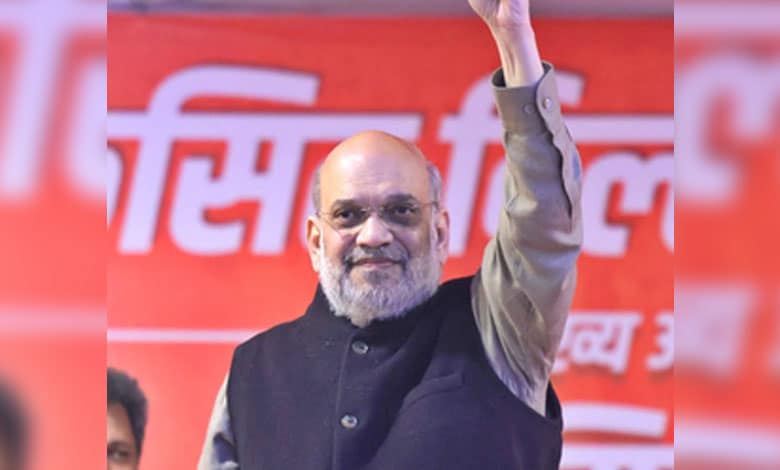Amit Shah to Visit Maha Kumbh, Take Holy Dip at Triveni Sangam
Union Home Minister Amit Shah will visit the Maha Kumbh in Prayagraj on January 27 to take a holy dip at the Triveni Sangam. Accompanied by Uttar Pradesh CM Yogi Adityanath, he will participate in the sacred rituals and highlight the unity and cultural significance of the event.

Union Home Minister Amit Shah is set to attend the Maha Kumbh in Prayagraj on January 27, where he will take a holy dip in the Triveni Sangam, the sacred confluence of the Ganga, Yamuna, and Saraswati rivers.
The event marks a key moment in the ongoing Maha Kumbh Mela, one of the largest and most spiritually significant gatherings in the world. Uttar Pradesh Chief Minister Yogi Adityanath will accompany the Home Minister during this significant ritual bath on the 15th day of the Maha Kumbh.
Table of Contents
Amit Shah’s Arrival at Maha Kumbh
Amit Shah’s visit to the Maha Kumbh is expected to attract significant attention, both from religious devotees and political circles. According to the scheduled itinerary, Amit Shah will arrive at Bamrauli Airport at 11:25 a.m.
He will then take a helicopter to the DPS helipad at 11:50 a.m., heading towards Arail Ghat at noon. From there, he will board a boat to the VIP Jetty, where he is expected to arrive at around 12:15 p.m.
The Home Minister’s participation in the holy dip is seen as an expression of both his devotion and a significant political gesture, considering the cultural importance of the Maha Kumbh.
Significance of Maha Kumbh and the Triveni Sangam
The Maha Kumbh Mela, which started on January 13 with the ‘Pavitra Snan’, has drawn millions of devotees from across the country.
The ritual bath at Triveni Sangam holds immense spiritual significance, with devotees believing that taking a dip in the confluence of the Ganga, Yamuna, and Saraswati purifies the soul and brings blessings.
The event spans over several weeks, with key bathing dates like Mauni Amavasya (January 29), Basant Panchami (February 3), and Magh Purnima (February 12), culminating on Maha Shivratri (February 26).
Despite the harsh winter conditions, over 10 crore devotees have already partaken in the sacred tradition, making this year’s Maha Kumbh one of the most attended in history.
The event is not only a religious observance but also a celebration of unity and diversity, welcoming people from all walks of life and faiths to join in the rituals.
Unity and Cultural Message
Amit Shah, during his recent visit to Gujarat, emphasized the universal message of the Kumbh Mela. He remarked that the Kumbh symbolizes unity and harmony, as it does not discriminate based on religion, caste, or sect.
He urged the youth of Gujarat to witness the event, noting that the Maha Kumbh happens once every 144 years, making it a once-in-a-lifetime experience.
Shah also shared his personal connection with the Kumbh, revealing that he has attended the event nine times and even witnessed the Ardh Kumbh, a smaller scale of the Kumbh Mela.
“The Kumbh gives the message of harmony and unity. It does not ask which religion, sect, or caste you belong to. Food is available without discrimination.
No event in the world conveys a stronger message of unity than Maha Kumbh,” he said, emphasizing the inclusive spirit of the festival.
Also Read | Delhi Poll Battle: HM Amit Shah to Hold Public Meetings and Roadshow Today
Dharma Sansad and Sanatan Dharma Unity
Simultaneously, the Virat Sanatan Dharma Sansad, a major spiritual gathering, will take place at the Shanti Seva Camp in Prayagraj, led by the renowned spiritual guru Devkinandan Thakur.
The assembly will feature key religious figures, including the Shankaracharya, heads of 13 Akharas, and various sadhus and saints from across India.
The Dharma Sansad aims to foster unity and promote the teachings of Sanatan Dharma, which is central to the spiritual beliefs of millions of Hindus.
The congregation at the Dharma Sansad will address critical religious and social issues while reinforcing the shared values and beliefs that bind the followers of Sanatan Dharma.
The participation of Amit Shah in the Maha Kumbh and the Dharma Sansad reflects the Indian government’s deep engagement with the cultural and spiritual fabric of the nation.
Maha Kumbh: A Historic Spiritual Event
The Maha Kumbh Mela is a grand spectacle that brings together millions of pilgrims, saints, and spiritual leaders. It is one of the world’s largest peaceful gatherings and has been recognized by UNESCO for its cultural and spiritual significance.
As the world’s largest religious congregation, it serves as a reminder of the importance of faith, unity, and devotion.
In addition to the religious rituals, the event plays a key role in the social and cultural life of India. It offers an opportunity for individuals from different parts of the country to experience shared traditions and practices, reinforcing the collective identity of the Hindu community.
The Maha Kumbh Mela has also become a symbol of India’s rich heritage and spiritual history, attracting visitors from around the globe.
